John Farrow introduced our guest speaker, Doug van der Horden, who is here to speak with us about preventing human trafficking in the Kingston area. You will remember that Doug received a Paul Harris designation from us last year for his work for the last 12 years trying to help prevent human trafficking in this area. He is a counselor at Ernestown Secondary School, and has held several interesting jobs in the past.
Doug complimented us on the awesome vibe in the room at 7am! His presentation is usually 3 hours long, so he can only just skim the surface in the next 20 minutes.

Doug has been with the School Board for 12 years, and has had a varied past – military (member of the Vimy Band), pastor, musician, Salvation Army worker in the prisons, and youth worker. He went back to school when he got out of the military and had a child on the way. When he was in college, he saw a film called Human Trafficking with Donald Sutherland in it. At that time, the topic was not anywhere on Doug's radar, but it affected him profoundly and he started to approach anyone he could who worked with folks living on the street – trying to learn more about it.
Human Trafficking is such a complex issue. The Alliance for Action committee was formed locally in an effort to get the attention of the police and the major crimes unit. The Chair of the group approached the police chief and they had their first meeting after three years of trying to get together with the Police – the police knew nothing. It was not on their radar either, and they didn’t have the resources to deal with it. Alliance for Action had been looking into trafficking for 4 years, and the police were more than willing to listen to them and learn.
What exactly is human trafficking? In simple terms, it is the illegal sale of human beings like commodities in order to meet a demand for forced labour or sexual slavery. It's different than human smuggling, where people pay to get into a country illegally, although once there these smuggled people are very vulnerable to being trafficked. Every 30 seconds worldwide someone becomes a victim of human trafficking. Victims are being forced, even if they’re being paid. The psychological bond with the trafficker is SO strong, it’s very hard for younger, disadvantaged youth to break free. The average age of someone being trafficked is 12 to 15 years, and there have been local cases, some of which are still working there way through the courts. Girls represent between 70-80% of trafficked people, and it doesn’t necessarily mean transporting them far away. Sometimes these girls are being given a roof over their heads and are being pimped out, right here, in the Kingston area. The 401 corridor is a trafficking artery (Doug has done presentations to the En Route staffs and managers).
5 years ago, Timea Nagy, a survivor and advocate came to speak with in Kingston and at Kingston General Hospital, and awareness has been building. Alliance for Action is no longer a working group, but Doug is still going. CBC Radio reported that the best way to combat trafficking is to educate our young people. Doug and others have been presenting to kids grade 7 and 8 and up to increase their awareness.
There are 2 types of trafficking: domestic or international. Doug focuses on domestic – within this country and our neighbourhoods. We he asks within his school how many people thought trafficking was happening within our country, province? Sure! Within our community? People answer no, it’s not happening in our community – but guess what? It is! Social media facilitates reach-outs from traffickers in large cities. Doug related a story of one group home kid who was moved to another city. She disappeared and , couldn’t find her anywhere, and surfaced eventually over social media and because of the education we’re doing, her friend identified a false reach-out and a ‘sting’ operation was organized. In Odessa!
Cops got the girl back, and it was traced to a prostitution ring in Toronto.
There are 3 types of pimps: a prevalent one is the Romeo pimp– a few years older than the girls and works at winning them over and builds an online relationship with them. Then they isolate them from their family and friends and introduce them to the sex trade. It's really hard to get the girls back at this point. Videos are often used for blackmailing. Then Romeo asks a favour…… just this one time. This is the type of pimp that is seen most often.
Doug asks the kids – what do you think a pimp looks like? There are the stereotypically dressed ones (big hat, fur coat, cane, gold jewelry, etc.), but a lot of them are young, average-looking women! You wouldn't pick them out in a crowd.
President Ana Sutherland thanked Doug for his very enthusiastic and informative presentation on this disturbing topic……

Who do you call if you suspect someone is being trafficked? The Canadian Human Trafficking Crisis Number is 1-833-900-1010. You can also contact Kingston Police or Victims Services at 613-548-4834. You can follow Doug's work on Facebook at; https://www.facebook.com/fast.kingston/?ref=bookmarks

